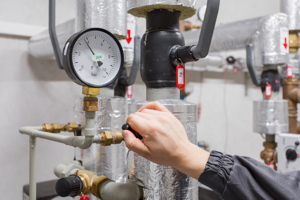Enjoying the benefits of retrofit projects

Paul Wightman of Albion Valves shares his enthusiasm for the benefits of a phased approach to upgrading building-services systems such as space heating.
A shiny, new upgrade is hard to resist — whether it’s a smart phone, car, computer, or any other gadget. The latest, highest-spec model on the market is always the catalyst for consumer change, swiftly relegating last season’s technology and rendering it obsolete.
However, in building systems change can often take a much slower pace, it is more considered and for good reason. Retrofitting an existing building can often be much more cost-effective and deliver better results than creating a new facility.
A well-designed retrofit enhances all the existing benefits of the original building, as well as improving sustainability and boosting performance; however a carefully measured and phased approach is essential.
Indeed, introducing new technology into an older system can often be a highly problematic mismatch, whereas a gradual, phased introduction of technology can offer more suitable long-term compatibility.
Examples of this successful phased approach exist all around us in the buildings we occupy every day. Schools, hospitals, retail outlets and office blocks are all places where retrofitting occurs in timely stages and within contained zones on a regular basis.
In most commercial buildings refurbishment work is usually carried out during downtime, at night or while the building is unoccupied, to minimise disruption to business.
 |
| The key to converting constant-flow heating systems to variable-flow— PICVs (right) and DPCVs (left). |
It is not always necessary to tear out all the building infrastructure and pipework to retrofit. It is entirely feasible for a modern, efficient system to be created using existing materials with a few strategic tweaks. This will result in saving money on energy for a fraction of the cost of a new installation, as well as achieving a short payback period via the savings.
For example, an older hot-water heating system designed around a constant-volume supply system, whereby all of the water needs to be circulated all of the time around the entire building, would typically be controlled via 3- or 4-port motorised control valves.
In a modern, variable volume system, those 3- or 4-port valves are changed or made redundant by the use of 2-port valves. Therefore, heating engineers working on a retrofit of this kind of heating system could consider updating to 2-port PICV hydronic balance control, essentially meaning that only the water required is delivered to a specific location — with no wasted energy and needless circulation of water around the system.
Hence, a 4-port constant volume system could be upgraded quite easily and cost effectively at each terminal unit to a variable-volume system — offering significant savings, even on older installations.
Similarly, if the pipework is in good condition on a HVAC project, then the terminal units such as fan-coil units, overdoor heaters and internal water coils are likely to be equally sound. They is central to the delivery of the heating service and may not need replacing. However, to boost efficiency and comfort performance, the controls may benefit from improving speed control on the fan in a fan-coil unit to optimise airflow over the coil, which can add years to the system’s service life.
Additionally, another simple measure to be considered to help avoid problems in the longer term is for heating systems to have thermostatic radiator valves (TRVs) fitted on radiators. This would mean that the circuit closes down at optimum temperature, therefore preventing overheating and wasteful energy in terms of boiler gas consumption and circulating-pumping costs.
The specification of technical products for retrofits should also consider the installation of on-off control valves on HVAC systems to help prevent unnecessary heating or cooling of unoccupied rooms or zones within the building.
 |
| if the pipework is in good condition on an HVAC project, then the terminal units such as fan-coil units, overdoor heaters and internal water coils are likely to be equally sound. |
Solenoids are another invaluable and inexpensive preventative measure that can be easily fitted to increase the efficiency credentials of older systems, by preventing dripping taps, non-closures and leaks to save water.
A retrofit, carried out in conjunction with taking preventative measures with HVAC systems, can ultimately mean less investment, less operational downtime and less ongoing maintenance issues.
HVAC equipment coming to the end of its service life can mean expense and unplanned system downtime; however, facilities managers can pre-empt potential issues with ageing HVAC systems by timely retrofitting.
Paul Wightman is technical specifications manager with Albion Valves.







